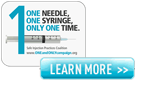Survivor Stories Blog
Drug Diversion Reporting…what more can be done

My sincere thanks to the Denver Post’s David Osher and Christopher Olinger for their in-depth piece on drug diversion, reporting and treatment on 4/24/2016.
http://www.denverpost.com/news/ci_29806013/drug-addicted-dangerous-and-licensed-operating-room
In this piece, spurred on by the maelstrom of events which surrounded the arrest of a surgical tech from Swedish Medical Center the previous month, Osher and Olinger point out the simple truth that hospitals do not all prescribe to the same standard of safety and precaution when a drug diversion occurs. It was made clear that simply not reporting a theft, leaves open the possibility of hiring of these drug diverting healthcare workers at other facilities and allow them to continue their diverting ways. These reporters did an extensive job in reviewing state health department, licensing board and police records. And the results were unbelievable.
Read more
A Survivor reacts to a new outbreak

Recently West Virginia health authorities announced that a cardiac clinic is at the center of an investigation of a potential outbreak of viral hepatitis through unsafe injection practices. Johnny Robertson of North Carolina is a survivor of a similar outbreak and is an active advocate of injection safety. We are grateful to Johnny for his leadership in patient advocacy. Following is his reaction to the outbreak.
In January 2008, I heard the words, “You have hepatitis C.” This diagnosis changed my life completely.
I contracted hepatitis C during a stress test at a cardiology clinic in North Carolina in 2007. Later, it was revealed that a medical technician administered saline solution to a patient who was infected with this life threatening disease, then reused the same syringe to re-enter the vial. This contaminated the vial of medication with the virus. Subsequent patients who received an injection from the saline solution vial were exposed to the virus. Five patients were infected with the virus, but many more were exposed and were urged by the state health department to be tested.
Several weeks ago, West Virginia’s Department of Health and Human Resources sent letters to 2,300 people potentially exposed to hepatitis B, hepatitis C and HIV through cardiac stress tests at Raleigh Heart Clinic in Beckley. From the recent article (“Hepatitis cases linked to Beckley clinic likely caused by human error,” March 29), we know that 12 patients have been infected with hepatitis C or hepatitis B.
This tragic news strikes an eerily similar tone.
In addition to the dozen patients who have been infected, my heart breaks for the patients who sit and wait and worry while results from blood tests come back. I offer them my deepest support.
Outbreaks like this one oftentimes affect entire communities. Families and friends and colleagues are affected. They take a toll on the human psyche, and they are complicated and costly.
The truth of the matter is this could have been prevented. It did not need to happen.
Generally, healthcare in the United States is very safe. But sometimes, unsafe practices are used—brought about by ignorance, desire to cut costs, or the demand to see more patients in a shorter amount of time.
But there are efforts to educate both healthcare providers and consumers about the absolute need for safe injections in all settings.
I work alongside colleagues at Hepatitis Outbreaks’ National Organization for Reform and North Carolina’s One & Only Campaign. I am proud to serve as a spokesman for this award-winning campaign. I tell my story to healthcare providers throughout the state to help reeducate and advocate for injection safety, urging them to use “One needle, one syringe, and only one time!”
Patients need to have a voice in healthcare. No one in the United States should be infected with hepatitis C while receiving healthcare. My hope is to support those who are going through this very difficult time and allow the conversation to begin about tighter safety protocols, in West Virginia and elsewhere. There is help out there for those who need it. I know because I was once in this same situation.
Johnny Robertson
Healthcare workers and addiction by Kristin Labott-Waite

With all the recent drug diversion incidents swirling around, we thought we would feature a guest blogger, Kristin Labott-Waite, to share opinions on healthcare workers and addiction. This is a re-print from her blog posted January 2, 2016.
As I sit here today with my good friend Butch and his daughter Paige, I am reminded that life is very short. Paige has melanoma in her brain and it has been progressing in recent weeks. We do not know what to expect next and that is the scariest thing. While I sit here I am contemplating why things happen the way they do. Why, after all the shit I pulled am I healthy and strong, and 22 year old Paige is so sick. Paige has a 16 month old daughter to take care of too. It isn’t fair. She is on all kinds of pain medication, fentanyl patches, Dilaudid, morphine, meds she needs to keep the headaches at bay. I know that she is using those meds because she needs them. While we sit here at the hospital I worry about people stealing the meds she so desperately needs. Read more
Drug Diversion Management; A Resource Guide

Over the past few months, the news has been riddled with stories of a surgical tech who diverted drugs in 4 states. He was finally caught in Colorado when a fellow employee finally turned him in. But the question remains, how did he go from a Navy court martial to wreaking havoc across multiple states and several hospitals?
We hear more about drug diversion, especially over the last decade, because we are catching more diverters. Kim New, executive director of the International Health Facility Diversion Association, states that “diversion almost certainly occurs at every institution that handles controlled substances, and the rate of discovery of diversion events has increased steadily over the past decade. “ And while most facilities have certain protocols in place, there is no formal set of rules to govern all, so there remains lots of gray areas which allow employees to slip through the cracks.
Read more
Take the pledge for Patient Safety Week!
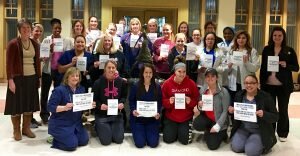
I was honored recently to speak to the RN to BSN nursing class of the College of St Mary in Omaha, NE. It was heartwarming to interact with such eager and engaged nursing students – their passion for quality nursing care is contagious! The discussion was lively and revealed the students’ quest to understand how they can assure that their care of patients will always be safe.
It was particularly timely to visit the class because this week is National Patient Safety Week and the launch of the healthcare provider pledge for injection safety. Healthcare providers throughout the country will be pledging:
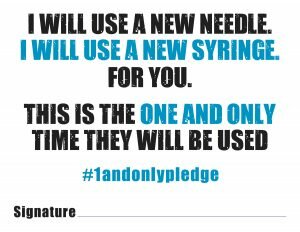
We urge you to take the pledge as well. If you are a healthcare provider, have some fun with taking a selfie with your signed pledge and posting it to your social media channels. Get a group shot with your colleagues. If you are a patient, ask your healthcare provider to sign and take a picture of yourself with her holding the pledge. Here are several pictures of some of my favorite healthcare providers with their signed pledges:
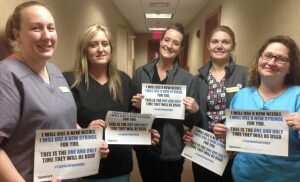
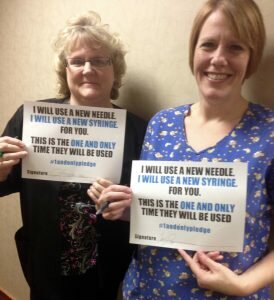
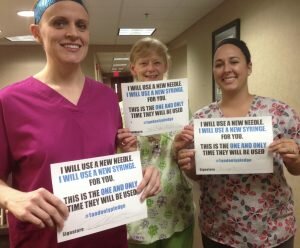
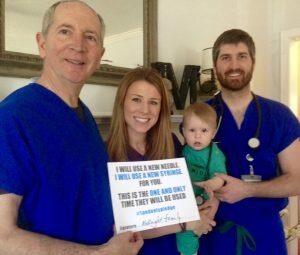
Will you sign this pledge?
“I will use a new needle. I will use a new syringe for you. This is the one and only time they will be used.”
Not in my backyard! – When outbreaks happen again in our own hometown

Several new investigations into healthcare associated transmission of bloodborne pathogens have been reported lately. Lauren recently reflected on an investigation into possible drug diversion by a surgical tech that could result in transmission of hepatitis C from the surgical tech to patients through reuse of syringes in the Denver area. A recent news article reported on a situation in which a nurse employed by an Omaha wellness company reused two syringes to administer 67 flu shots.
Of course we are horrified by these potential outbreaks, as we always are whenever there are reports of unsafe injection practices. Our hearts go out to those affected by the unsafe practices. We know the anxiety, anger and betrayal that many feel, because we have felt those same feelings ourselves when we contracted Hepatitis C through reuse of syringes and medication vials.
But what makes these reports of potential outbreaks even more difficult for us, is that they are linked to our own backyards.
Lauren lived in the Denver area for many years, and was affected by the Rose Medical Center outbreak through drug diversion in 2009. Evelyn lives in Fremont, NE forty miles from Omaha, and was one of 99 people who contracted Hepatitis C through reuse of syringes during chemotherapy in 2002.
Ever since we were harmed by unsafe injection practices, we have worked hard to educate about and advocate for injection safety. We have wept with victims, argued with policy makers, and encouraged healthcare providers, educators and administrators to do the right thing for many years now. The work is consuming, demanding, – but usually rewarding.
But when the outbreaks happen in our own backyard, we feel so many more emotions. Anger. Frustration. Discouragement.
Perhaps the most salient emotion is bewilderment. How can this be? Didn’t everyone read about our outbreak in the newspaper, or see a report on TV? Wasn’t everyone shocked and horrified? Didn’t we hear over and over again – “We can’t let this happen again!”
And yet it did. Of course changes were made – even sweeping changes – right after our outbreaks. We were gratified by the improvements that we saw implemented. But time moves on – people change jobs, memories dim, attention to safety is threatened by the demanding pace, or cost cutting, or a culture of poor communication within the healthcare team. And then reuse of medical equipment intended for one time use happens again, either intentionally or unintentionally.
And then we are back to where we were years ago – weeping with victims, arguing with policy makers, encouraging healthcare providers, educators and administrators – in some instances the very same officials we interacted with at the time of our outbreak.
At times like these we have to sit back, take a deep breath, and reflect on our advocacy. Are our efforts worthwhile? Should we continue? And almost immediately, the answer comes from deep within – “YES!”
For although we learn through the media for months about the number of people who were affected by unsafe injections in our hometowns, we do not know how many people we have saved from injury through our efforts. We know it is a great many. We know that the educational efforts of the One and Only Campaign and the advocacy efforts of the Drug Diversion Prevention Committee are making a difference. We know this whenever someone comes up to us after hearing us speak and tells us, “I’m taking your story back to my co-workers, and we are going to make some changes!” We carry those statements in our hearts, and bring them to the top of our minds at times like these.
So. Back to work. Lets all commit to making “One needle, one syringe, and only one time” happen everywhere in the world, not just in our own backyards.
Another plea for a national healthcare registry

News broke a few weeks ago about a possible drug diversion event in Colorado. The more we here about the details of this incident, the more we understand just why a national registry for healthcare workers is so important. Even with the current registry the state of Colorado has for surgical technologists, we see that we have still fallen short in regard to gaps in the system.
It appears the surgical tech who was caught with a syringe in an operating room where he was not scheduled has lost every previous hospital job due to drug violations. At least one other job he was caught stealing a syringe and in still another he tested positive for fetanyl. It appears 4 states are now involved in an ongoing investigation. Read more
Advocating for Safe Patient Care on Capitol Hill

I was fortunate to be part of a group of committed advocates who met with their congressional delegation to advocate for safe patient care. Join us in our efforts as we share our story here in a two minute video.
Another Drug Diversion Event in Colorado

This past week we learned that there was another incident of drug diversion at Swedish Medical Center in Englewood, Colorado. This is not far from Rose Medical Center in Denver, the site of the 2009 drug diversion event which caused 19 patients to be infected with Hepatitis C. So if this seems eerily familiar, you are right, it is.
At last report, no exposure to any infectious diseases have been reported. My sincere hope is this remains to be the truth for the almost 3000 patients who were notified that they may have been put at risk.
But the cold hard facts remain. There was another drug diversion at an HCA hospital, the same hospital system which includes Rose Medical Center. And I am sure the most asked question is going to be “Why?” Why were there not better systems put into place to safeguard again this? Why did we not learn from the mistakes made in 2009?
We ask why because we know this was a completely preventable event. We ask why because despite any reliable data about the frequency of drug diversion in healthcare facilities, primarily due to the covert nature of this crime, we know it is always a possibility, always a risk. We ask why because there are many hospital systems who have successfully been able to monitor, assess and prevent drug diversion incidents.
So while my thoughts remain with those 3000 patients and their families and friends as they await news of their blood tests, I find comfort in knowing behind the scenes the Colorado Department of Public Health and Environment is doing what needs to be done to investigate, educate and keep the risks at a minimum. With the help of the CDPHE’s One and Only Campaign, awareness is being raised among patients and healthcare providers regarding safe injection practices. Or if more information is needed, please contact HONOReform at www.honoreform.org.
Below you will find a guest commentary which appeared in the Denver Post this past Saturday offering solutions for the future.
Swedish Medical Center infection scare didn’t have to happen – The Denver Post
Celebrating our Successes

Nine years ago, HONOReform was launched. We pause here to review our many accomplishments. We give thanks to our loyal stakeholders and supporters, who have made all of this possible!
- HONOReform is an original member of the Safe Injection Practices Coalition, which is currently active in seven states and online at OneandOnlyCampaign.org. This award-winning campaign is led by our longtime partners at the CDC.
Read more




